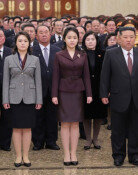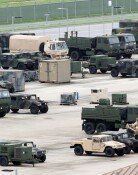[Editorial] Zero Tolerance for Violence
[Editorial] Zero Tolerance for Violence
Posted June. 22, 2009 08:44,
The Supreme Court has handed down guilty sentences on protesters who were ruled to have used violence that went beyond passive self-defense. The protesters in November 2007 threw stones at and used pipes against police officers. Police were trying to stop the demonstrators from leaving Gwangju for Seoul to participate in an illegal rally organized by the Korean Confederation of Trade Unions at Seoul Plaza. Even if the police officers acted irrationally, extremely violent resistance cannot be justified as self-defense. At a time when violence against public authority prevails in Korean society, the latest ruling has meaningful implications.
In last years demonstrations against the resumption of U.S. beef imports, protesters used violence against riot police for more than three months. The demonstrators burned down or damaged scores of police buses. A police officer taking into custody a protester who was caught red-handed was attacked by 10 protesters. Eight of the attackers, however, were released either after being put on probation or paying a fine. The judiciarys excessive tolerance of violence could be a major stumbling block in building a violence-free society.
Excessive violence against public authority is rampant in Korea, so much so that the rule of law is apparently in serious crisis. Several of the latest outbreaks of violence by protesters almost seem as if their sole purpose is to incapacitate public authority or subvert a legitimate government. If such violence is tolerated, law and order will break down and negatively affect the people. Therefore, the judiciary has an important role to play as the final judge on any violent action.
Previous leftist administrations glorified violent and illegal protests as democratic movements, and even rewarded those involved. As a result, violent and illegal demonstrations have become a chronic problem. On the Sabuk coal miners uprising in 1980, the Supreme Court ruled that miners who lynched the wife of a union leader must pay damages. Under the Roh Moo-hyun administration in 2005, however, the Democratization Rewards Committee recognized the miners as democratic protesters. The decision leaves much room for doubt. Though the latest ruling against violent protesters does not get to the heart of the Sabuk controversy, the Supreme Court did recognize as an assailant one of the miners who had been honored for his involvement in democratization after several past claims on the incident were found false.
The committee also recognized protesters involved in the 1989 Dong-eui University incident in Busan as democratic activists, though the demonstrators burned seven police officers to death. The officers had entered one of the universitys buildings to rescue their kidnapped colleague.
The recent violence against public authority is largely different from the past, when the public had to rise up against an authoritarian government. Back then, resorting to violence might have been unavoidable. Times have changed, however, and the judiciary must make clear the principle of zero tolerance of violence through its rulings.







